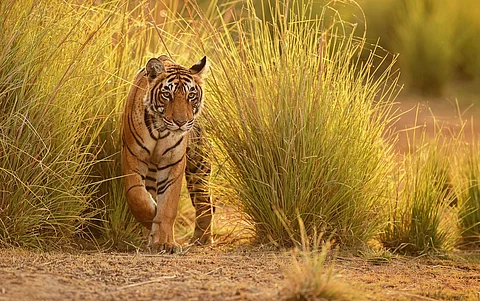

This is the second of a 5-part series. Read the first, third, fourth and fifth parts
A total of 22 people have been killed by tigers in Maharashtra this year, with 11 of those deaths happening in just 17 days of May in the state’s Chandrapur district.
Apart from Maharashtra, five people have been killed in tiger attacks in Uttar Pradesh’s Pilibhit Tiger Reserve. The first was reported on May 13.
Meanwhile, nine people lost lives this year in Uttarakhand in attacks by tigers. In Rajasthan’s Ranthambore, three people—including a forest range officer and a forest guard—lost their lives in tiger attacks.
In Balaghat, Madhya Pradesh, one man was mauled to death in the month of May. A woman in Karnataka was killed by a tiger in the BRT tiger reserve in June.
At least 41 people across India have been killed in tiger attacks within a span of six months this year. In some cases, the tigers have partially eaten their prey.
As per government records submitted to Parliament last year, 44 people had lost lives in tiger attacks in India by June 2024. The highest recorded deaths due to tiger attacks were registered in 2022, amounting to 110 in a single year.
Experts and forest officials assert that a majority of these encounters were ‘accidental’. At the same time, they raise crucial questions on the increasing tiger presence in human-dominated landscapes, lack of prey, degrading habitats and conservation strategies of one of the most protected species on the planet.
Manish Singh, divisional forest officer at Pilibhit Tiger Reserve, says the five reported attacks in the reserve occurred in different areas. “There are only two cases where the tiger consumed the human. This is mainly because it took time for the locals to locate these victims and the tigers got an opportunity to revisit and consume the dead,” he explained.
Singh said these incidents were accidental and involved three to four tigers. “The instances occurred within 100-300 metres of the forest area, where humans grown sugarcane in close proximity to the forest,” he noted.
Dharmendra Khandal, conservation biologist with Tiger Watch, an organisation based in Ranthambore working towards wildlife conservation, said humans are very much part of tigers’ diet.
“Humans have no natural defence whatsoever and cannot run fast like deer or other ungulates. Given an opportunity, a tiger may attack humans as prey,” he said.
K Ullas Karanth, conservation biologist and a tiger expert, said tiger attacks have nothing to do with tigers acquiring a “taste for human flesh” but more to these animals losing their fear of human beings when the latter are vulnerable.
Anish Andheria, president of the Wildlife Conservation Trust, said tigers have no taste buds and can eat rats, crocodile, herbivores and even carrion as part of their diet if their hunting attempts fail.
He said attacks by tigers are also caused mainly by cubs 15-16 months of age, who are inquisitive or mothers who are protective about their cubs.
In the case of Ranthambore, the experts said the incident occurred as the tigers were provided baits by humans.
Forest officials in Ranthambore provided bait animals to the tigress ‘Arrowhead’, who was unable to hunt due to her hip deformity. She also had three cubs to support. Earlier this year, the cubs attacked humans.
Khandal added that this phenomenon is not widespread but mirrors the instances of tigers in different reserves and how they interact with humans. “In the case of Ranthambore, the cubs associated humans with food and probably initiated the attacks,” he said.
Carnivore biologist Abhishek Harihar said the first preference of tigers other than their natural prey will always be cattle, which is similar to gaur and wild buffalo. “In general, tigers are not known to prey on primates,” he said.
Andheria said though tigers may prey on humans as it is easy to do so, his research shows that tigers will not primarily prefer humans. “A tiger may only become a compulsive maneater if it has a habit of coming back to its prey. But usually that never happens. Otherwise, we would see hundreds of human deaths by tigers as there are thousands of villagers who visit forests daily across India to collect minor forest produce, including forest guards who patrol the forests,” he added.
Krishnendu Basak, human wildlife conflict mitigation expert, said the sporadic incidences across India cannot be used to generalise the entire species as a threat. “On average, a single tiger kills around 50 prey animals per year to meet its dietary needs, which means it requires access to a population of at least 500 wild prey animals to sustain itself naturally. If we were to assume that all tigers were maneaters needing 50 humans annually, the numbers would be alarming,” he said.
In the Indian part of the Terai landscape (Pilibhit-Dudhwa), the estimated tiger population is around 224. If all of them were maneaters, they would collectively need to kill 11,200 humans annually. Yet, the average number of human deaths attributed to tiger attacks in this region is approximately 20 per year — just 0.17 per cent of the hypothetical total, Basak explained.
These statistics clearly indicate that the vast majority of tigers are not maneaters.